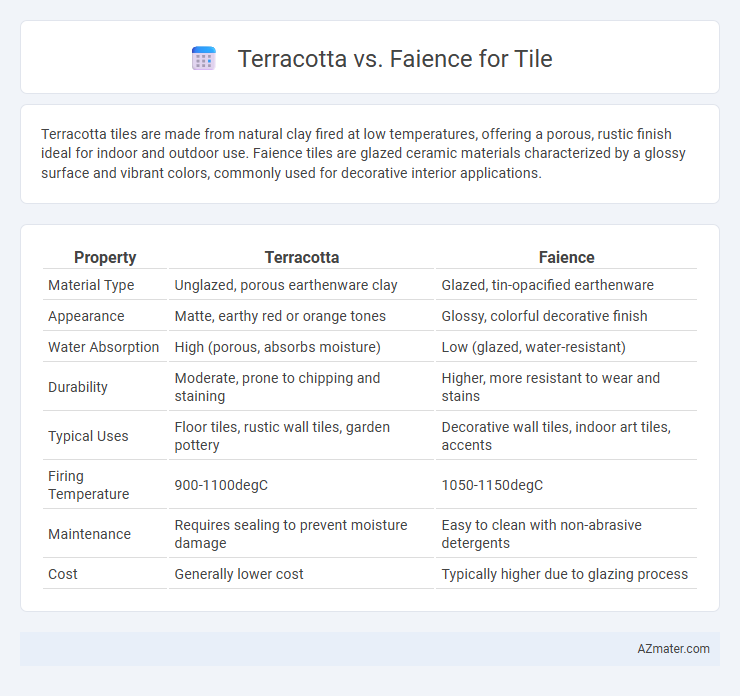Terracotta tiles are made from natural clay fired at low temperatures, offering a porous, rustic finish ideal for indoor and outdoor use. Faience tiles are glazed ceramic materials characterized by a glossy surface and vibrant colors, commonly used for decorative interior applications.
Table of Comparison
| Property | Terracotta | Faience |
|---|---|---|
| Material Type | Unglazed, porous earthenware clay | Glazed, tin-opacified earthenware |
| Appearance | Matte, earthy red or orange tones | Glossy, colorful decorative finish |
| Water Absorption | High (porous, absorbs moisture) | Low (glazed, water-resistant) |
| Durability | Moderate, prone to chipping and staining | Higher, more resistant to wear and stains |
| Typical Uses | Floor tiles, rustic wall tiles, garden pottery | Decorative wall tiles, indoor art tiles, accents |
| Firing Temperature | 900-1100degC | 1050-1150degC |
| Maintenance | Requires sealing to prevent moisture damage | Easy to clean with non-abrasive detergents |
| Cost | Generally lower cost | Typically higher due to glazing process |
Introduction to Terracotta and Faience Tiles
Terracotta tiles are made from natural clay, fired at high temperatures to create durable, porous surfaces with a distinctive reddish-brown color, often used for rustic and earthy designs. Faience tiles are glazed ceramic tiles known for their smooth, glass-like finish and vibrant colors, commonly utilized in decorative and architectural applications. Both materials offer unique aesthetic and functional qualities, with terracotta prized for its natural warmth and faience valued for its intricate patterns and glossy appearance.
Origins and Historical Context
Terracotta tiles originated in ancient Mesopotamia and the Mediterranean, crafted from natural clay fired at low temperatures to create durable, reddish-brown surfaces widely used in flooring and roofing. Faience, developed in ancient Egypt, is a glazed non-clay ceramic composed primarily of crushed quartz and silica, known for its bright blue-green color and decorative applications in tiles and small artifacts. The distinct materials and firing techniques reflect their unique historical and cultural contexts, with terracotta emphasizing functional architecture and faience serving ornamental and symbolic purposes.
Material Composition and Production Methods
Terracotta tiles are made from natural clay that is fired at lower temperatures, resulting in a porous and earthy material with warm reddish tones, while faience tiles are composed of a silica-based ceramic body coated with a glassy enamel and fired at higher temperatures to achieve a glossy, vibrant finish. The production methods of terracotta involve shaping and drying the clay before firing, emphasizing handcrafted techniques, whereas faience requires multiple firings, including glazing and decorating steps, to create intricate, colorful designs. Material composition impacts durability, with terracotta being more porous and prone to moisture absorption, while faience's vitreous surface provides greater water resistance and decorative versatility.
Visual Characteristics and Aesthetic Appeal
Terracotta tiles possess a warm, earthy tone with natural variations in color, offering a rustic and organic aesthetic that enhances Mediterranean and Southwestern designs. Faience tiles feature a glossy, glazed surface with vibrant colors and intricate patterns, providing a more decorative and refined appearance suitable for artistic and traditional interiors. The matte finish and textured surface of terracotta contrast with faience's smooth, reflective glaze, influencing the choice based on desired ambiance and visual impact.
Durability and Performance
Terracotta tiles offer moderate durability, ideal for low-traffic indoor areas, with natural porous characteristics requiring sealing to resist moisture and staining. Faience tiles provide superior performance with a glazed, non-porous surface making them highly resistant to water, stains, and wear, suitable for high-traffic and wet environments. The choice between terracotta and faience hinges on the specific performance needs, where faience excels in durability and maintenance ease compared to the more delicate, rustic terracotta.
Applications and Ideal Uses
Terracotta tiles excel in outdoor and rustic applications due to their porous nature and natural reddish-brown color, making them ideal for patios, garden pathways, and Mediterranean-style interiors. Faience tiles, known for their glazed surface and vibrant colors, are best suited for decorative indoor spaces such as kitchens, bathrooms, and accent walls where moisture resistance and intricate patterns are desired. Both materials offer unique aesthetic and functional benefits, with terracotta providing warmth and durability in dry conditions, and faience delivering glossy finishes and water resistance for high-humidity environments.
Maintenance and Cleaning Requirements
Terracotta tiles require regular sealing to prevent moisture absorption and staining, and they should be cleaned with pH-neutral cleaners to avoid damage. Faience tiles, made from glazed ceramic, are more resistant to stains and water, making them easier to maintain with simple wiping and mild detergent cleaning. Both materials benefit from gentle, non-abrasive cleaning methods to preserve their surface integrity and aesthetic appeal.
Cost Comparison and Value
Terracotta tiles generally offer a lower upfront cost compared to faience tiles due to their simpler production process and abundant natural clay materials. Faience tiles, crafted from glazed ceramic with intricate designs, carry higher manufacturing expenses that translate to increased purchase prices. While terracotta provides affordable rustic charm and durability, faience tiles deliver greater aesthetic value and long-term appeal, often justifying their premium cost through enhanced decorative impact and potential property value appreciation.
Eco-Friendliness and Sustainability
Terracotta tiles, made from natural clay, are highly eco-friendly due to their biodegradability and low-energy production process, making them a sustainable choice for environmentally conscious construction. Faience tiles, produced using glazed ceramic techniques, involve higher energy consumption and the use of chemical glazes, which can impact their sustainability negatively compared to terracotta. Choosing terracotta supports reduced carbon footprints and promotes sustainability through its natural material composition and minimal environmental impact during manufacturing.
Choosing Between Terracotta and Faience Tiles
Choosing between terracotta and faience tiles depends on durability, aesthetic, and maintenance needs. Terracotta tiles offer rustic warmth, high porosity, and strong resistance to wear, ideal for outdoor or high-traffic spaces, while faience tiles provide vibrant colors, glossy finishes, and a glazed surface that resists stains, perfect for decorative indoor applications. Consider environmental exposure, desired texture, and color vibrancy when selecting the appropriate tile type for your project.

Infographic: Terracotta vs Faience for Tile
 azmater.com
azmater.com